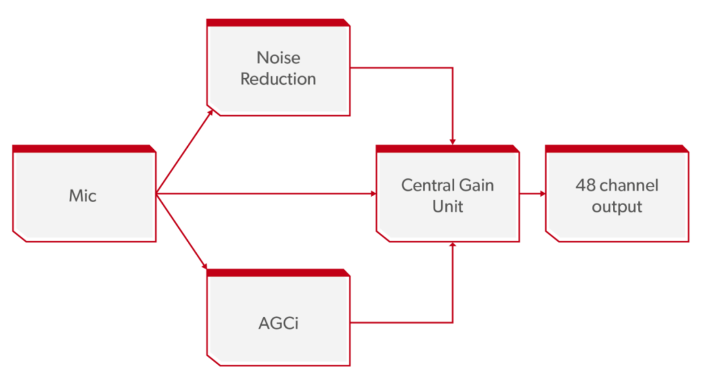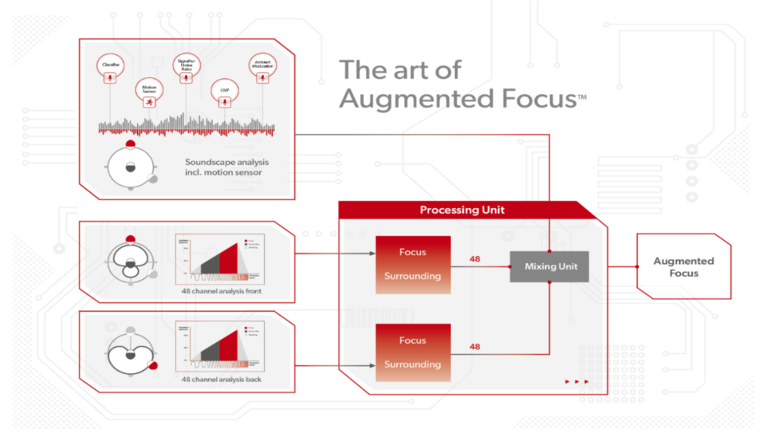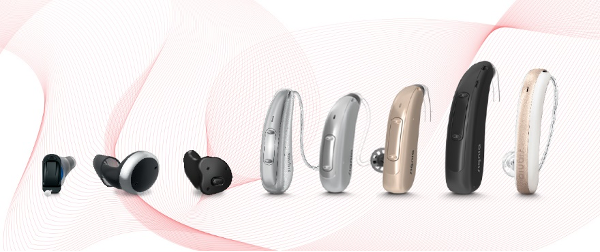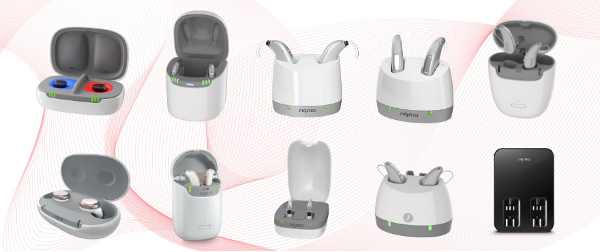Hearing Aid Technology to Improve Wearer Acceptance in Noise: How Signia Enhances Human Performance
AudiologyOnline: How does innovation from Signia contribute to wearer benefit?
Brian Taylor, AuD: First, I think we must acknowledge that the more hours per day a patient wears their hearing aids, the more likely they are to experience optimal levels of benefits. Intuitively, this makes sense, but more importantly, a substantial amount of research also supports this point. For example, a 2020 study by Anna Jilla and colleagues1, published in the Journal of the American Academy of Audiology, found that the average wear time for a group of 152 adults was 12 hours per day and that daily hearing aid use was significantly associated with residual participation restriction on the International Outcome Inventory for Hearing Aids (IOI-HA), which is a big-picture measure of a wearer’s quality of life.
From a manufacturers' perspective, when a new product comes to market it must be designed so that persons with hearing loss can wear it successfully in all listening situations. We all know that when wearers begin periodically removing their devices, they are more likely to permanently end up in the drawer. At Signia, we are always looking for features that give wearers an edge in all listening situations but also have a range of fashionable looks to choose from.
AudiologyOnline: Let’s start with the most fundamental elements of performance. How does Signia think about helping people hear in quiet, less demanding listening situations?
Brian Taylor, AuD: Yes, hearing in quiet is often taken for granted, but studies2 indicate that most wearers spend the majority of their time in quiet listening places, such as watching television, conversing at home at the dinner table with one other person, or listening to music during quiet times. I think we must acknowledge that just because the listening situation is quiet and relatively free of noise, does not mean the situation is unchallenging. Some people are exceptionally soft spoken, the sound quality of modern TVs can be uneven, and the acoustics of an otherwise quiet room can make for difficult listening – even when there are no extraneous noises.
So much of overall benefit for just about all patients rests with optimizing audibility. That is, the ability of the wearer to hear quiet, average, and loud sounds must be restored by the hearing aid’s core signal processing system. That’s why matching a validated prescriptive target like the NAL-NL2 and verifying it’s within a few dB at various inputs is such a critical starting point. We know that when you feed the brain a steady supply of sound, you give the brain a much better chance of understanding the message.
Hearing care professionals need to trust the devices they are fitting have the appropriate compression parameters, a smooth, wideband frequency response, as well as the correct amount of gain that mirrors the wearer’s audiogram. Signia delivers on all fronts by proving excellent audibility for various input levels. Of course, it is essential for the hearing care professional to be involved in tailoring theses parameters for the individual through the fine-tuning and adjustment process.
I will give you one often overlooked example of an older feature that can have a dramatic impact on audibility. Automatic feedback cancelation systems have been used in hearing aids for a few decades. They work in a couple of different ways to identify and eliminate feedback, but essentially, they enable the wearer to receive adequate amounts of mid and high frequency gain without encountering acoustic feedback. You would think 20 years into the digital era that all manufacturers would have the same basic feedback cancellation system, but they do not.
Some manufacturers, including Signia allow for more gain before feedback is encountered. One key metric of a feedback canceller is additional gain before feedback (AGBF). Based on the findings of Marcrum and colleagues,3 there is an 8 to 10 dB advantage on AGBF for some hearing aid manufacturers' feedback canceller compared to others. This 8 to 10 dB advantage on AGBF can expand the fitting range of the instrument by 15-20 dB. This means that a hearing aid with a mediocre feedback canceller can match high frequency gain targets for losses up to 50dB at 4KHz, while a high quality feedback canceller can match high frequency gain targets for losses up to 65 or 70dB at 4 KHz.
AudiologyOnline: Let’s turn our attention to noisy listening situations. What technology does Signia offer that addresses the persistent complaint of hearing speech clearly in the presence of background noise?
Brian Taylor, AuD: Indeed, hearing in background noise is an age-old challenge. MarkeTrak, EuroTrak, and Hearing Tracker surveys as well as our own clinical experience tell us that most listeners are challenged to understand speech in background noise.
First, Signia acknowledges the scale and scope of this challenge; it helps to remember that even young, healthy adults with normal audiograms can sometimes struggle in background noise. Second, Signia marshals an array of technology to boost a wearer’s performance in noise. This includes several different types of processed-based, digital noise reduction algorithms that are designed to improve the listening effort of the wearer. A lot of manufacturers talk about improving listening comfort; we actually have data from several studies, including a few from independent labs, indicating Signia noise reduction algorithms contribute in a big way to reduced listening effort and may even improve speech intelligibility.4
Third, in situations with high levels of background noise, directional microphone systems are essential. Thanks to Signia’s pioneering efforts around the use of nearfield magnetic induction (NFMI) for full audio data transfer, their bilateral beamforming system is considered by many clinicians to be best in class. In Signia’s bilateral beamforming system, each instrument in a pair of hearing aids has two microphones. However, bilateral beamforming differentiates itself from unilateral beamforming, which is employed by several other manufacturers, by utilizing the wireless connection between devices. Signia uses near-field magnetic induction to accomplish this full audio data sharing between devices, unlike other manufacturers who employ 2.4 GHz, which is prone to occasional sound quality issues when used for wireless communication between devices.
In bilateral beamforming, hearing aids share directional information to provide added benefit over the unilateral beamformer. Studies with earlier implementations of bilateral beamforming have shown better speech understanding in noise for the hearing aid wearers – even when compared to adult listeners with normal hearing.5 It is worth noting that full binaural beamforming is often applied in the presence of loud background noise – typically, when the intensity level reaches just over 70 dB SPL for about ten seconds, the bilateral beamforming system is engaged and the hearing aids go into a narrow directional mode. This application of bilateral beamforming is based on research that says in situations with lower levels of background noise, the hearing aid should still provide some audibility for surrounding sounds and thus remain in a more omnidirectional pattern. To accomplish this, Signia is one of only two manufacturers using motion sensors to change the directional patterns of its microphones.6 Figure 1 illustrates the full audio data sharing capabilities of Signia’s bilateral beamforming system. Note that in listening situations of relative high intensity, say above 70 dB SPL, the directional pattern is quite narrow.

Figure 1. A schematic of full audio sharing between two hearing aids that underlies bilateral beamforming.
AudiologyOnline: That all sounds great, but don’t we have to be mindful of the limitations of even the best bilateral beamformers?
Brian Taylor, AuD: Yes, that’s an astute statement. The most effective bilateral beamformers are predicated on the talker of interest and the background noise remaining relatively stationary with an intensity above 70 dB SPL and a duration of about ten seconds before they narrow their directional pattern. Of course, there are many instances when speech and noise are coming from multiple directions and changes moment to moment. In those types of more complex listening situations, such as a cocktail party, bilateral beamformers, even those that incorporate motion detection in their processing, sometimes fall short of the wearer’s expectations.
Fortunately, there is a new approach to signal processing, introduced by Signia in 2021, that shows remarkable progress in these complex listening places. This new approach is found in the Signia Augmented Xperience (AX) platform and goes by the proprietary name, Augmented Focus. It is also described more generically as split-processing, and it is found in Signia’s AX hearing devices.
AudiologyOnline: I am unfamiliar with split processing. Can you tell us more about it?
Brian Taylor, AuD: I would be happy to. Signia engineers deserve a lot of credit for exploring how other industries such as cinema sound effect technicians and recording engineers think about signal processing and incorporate those ideas into split processing. Before I dive into the wearer advantages of split processing, it is important to have a good understanding of how Signia devices classify the listening environment of the wearer.
A key component of AX’s split processing is the analysis of the listening soundscape by the hearing aid’s signal classifier. Traditional classifiers use modulation and intensity level-based approaches to determine the type of listening environment of the wearer. Basically, hearing aids use a few select acoustic parameters to designate the soundscape into a limited number of classification buckets. Once in these classification buckets, appropriate algorithms can be applied. The obvious limitation is that soundscapes are extremely dynamic and often greatly exceed the few classification categories commonly used by other devices’ on-board classification system.
AX’s split processing takes the intensity level and modulation into account in identifying the acoustic environment. In addition, however, other acoustic factors assist in evaluating the wearer’s soundscape, including the signal-to-noise ratio, if the wearer is talking, overall ambient modulation of the environment, and if the hearing aid wearer is stationary or in motion. These additional factors allow for a more dynamic approach to managing the soundscape beyond a limited number of classification categories found in most other hearing aids.
Analyzing the soundscape is merely the first step in helping the wearer hear well in any listening environment. The next step is how the hearing aid processes and manages the listening situation. Like other modern hearing aids, AX’s split processor logically applies select algorithms for the listening environment as it identifies the situation. However, AX also takes two distinct approaches in how the processing is executed – this is where the split processing name comes into play.
The first key difference between AX’s split processing and traditional devices is the implementation of serial processing. With traditional approaches to amplification, the sound is processed in a serial, or step-by-step manner. For example, as shown in Figure 2, the digital noise reduction algorithm may be applied to the input signal first, followed by compression. This serial processing could result in some algorithms undoing or exacerbating effects of the other algorithms and could consequently introduce artifacts.

Figure 2. The serial processing pathway of sound found in all hearing devices except Signia’s AX.
In contrast, AX’s split processing applies parallel processing, illustrated in Figure 3. The signal is fed to each algorithm in a parallel fashion, so it is untouched artifacts that could result from the amplification when processed serially. Following the application of the parallel processing, a central gain unit brings the entire signal together without artifacts, which can result in the perception of poor sound quality. The result of parallel processing is a cleaner signal for the hearing aid wearer.

Figure 3. The parallel pathway of incoming sound in the AX platform. Note how the incoming signal is split compared to serial processing in Figure 2.
Along with the parallel processing, AX’s split processing utilizes another innovative approach designed to address a common issue associated with hearing aids and one we’ve already mentioned: maximizing speech intelligibility in background noise.
AX’s split processing implements directional microphones, which are part of a sophisticated amplification strategy. In a traditional approach, all input signals processed by the hearing aids would follow similar noise reduction and compression characteristics. That is, no matter if the input is speech, music, or stationary noise like a fan, all the sounds are processed in essentially the same way -- the input signal dominating the wearer’s soundscape would drive classification and compression characteristics. With directional microphones, this also meant that sounds from the rear direction would receive some additional attenuation as the sound was processed. However, the same overall noise reduction and compression characteristics would be applied regardless of the direction of a sound source. With AX’s split processing, the directional microphones are used to identify front and rear input signals as separate streams and consequently apply separate processing to each stream. This means that target sounds from the front, which are typically speech, are likely to receive compression and noise reduction better suited to maximize the clearness of the speech signal. The competing sounds from the rear field apply different noise reduction and compression characteristics. Applying different processing to each of the two streams helps the wearer more easily distinguish the target speech signal from the competing background signals. This concept is illustrated in Figure 4.

Figure 4. AX’s split processing, also known as Augmented Focus, separates input signals into two separate streams that are processed independent of one another. Unlike traditional single stream processors, each stream applies different amounts of compression and noise reduction to the incoming signals.
AudiologyOnline: Split processing sounds like a fresh and unique approach. What research can you cite that supports its effectiveness.
Brian Taylor, AuD: Signia prides itself on backing up every new product launch with several studies supporting its overall efficacy and effectiveness. After all, we want to make sure hearing care professionals have confidence that these features work like they are supposed to in real world listening situations. The AX platform launch in 2021 was no exception.
Several studies have been published, some of them conducted at the height of the COVID-19 pandemic, which evaluate AX’s performance in laboratory and real-world environments. In one laboratory study, experienced hearing aid wearers compared AX’s split processing with that of other newly introduced hearing aid technologies.7 The hearing aid wearers performed a modified American English Matrix test (Hörtech) using speech and laughter as the competing signals. With AX’s split processing, the hearing aid wearers scored significantly lower (better) speech reception thresholds than with other devices.
In the same study, the performance with AX’s split processing was compared to that of normal hearing participants using the modified American English Matrix test in two different listening situations. The first was designed as a moderate noise situation, similar to a cocktail party situation, and the second was designed as a louder, restaurant situation. For the moderate noise situation, the hearing aid wearers performed equivalently to normal hearing listeners. And for the louder noise situation, hearing aid wearers performed significantly better than the normal hearing listeners, consistent with previous investigations with binaural beamformers.
In a separate study,8 satisfaction ratings of experienced hearing aid users wearing their current hearing aids and AX platform hearing aids were compared. They were asked to first rate their own devices on a Likert-type scale (1 = ”very unsatisfied”, 7 = ”very satisfied”) with six categories as well as thirteen questions related to quality of life from the Speech, Spatial, and Qualities of hearing questionnaire (SSQ). Participants were then asked to follow a specific wearing schedule. They wore the new AX devices for two weeks followed by their own devices for one week and the AX devices again for one week. At the end of each wearing session they were asked to complete the same questionnaire. After the fourth and final wearing session they were also asked to complete forced choice preferences between devices for six different categories.
Results of the satisfaction scale showed a significant difference in favor of the AX platform for overall satisfaction, sound quality, speech intelligibility, and own voice. Questions regarding comfort and fit were not significant. For results of the SSQ questionnaire, all but one category were significantly different, and again in favor of the AX processing. The final forced choice questions indicated a 73% to 80% range of preferences for the AX platform and an overall preference of 78% for AX processing.
AudiologyOnline: Besides the signal processing innovations you mentioned, where else has Signia focused their attention?
Brian Taylor, AuD: In one word, albeit a peculiar one: consumer-centricity. I will give you a couple of examples. One, form factor or style doesn’t get the attention it probably deserves, which is a shame because some people who could benefit from hearing aids don’t use them because of the negative stigma that still exists.
It goes without saying that people are unique, with different attitudes, needs, styles, and personalities. Therefore, it’s important to provide them with a range of form factors, some that look more like consumer earbuds than hearing aids. Figure 5 shows the wide range of form factors available to customers through their hearing care professional. Hearing care professionals should have a lot of confidence in their ability to empower wearers when they have such an impressive range of form factors in their portfolio of offerings.

Figure 5. Signia offers hearing aids to meet a wide variety of patients’ hearing needs, preferences, and style.
Two, we know that most wearers want rechargeable solutions. They are perceived by many wearers to be easy to use and convenient, compared to conventional battery-operated devices. Therefore, Signia provides a wide range of user-friendly rechargeable options, as shown below in Figure 6.

Figure 6. Signia is a pioneer in rechargeable hearing aids, offering patients greater convenience and ease of use.
Those are a couple of reasons why Signia has gone to great lengths to understand the consumer, identify their concerns, and determine what might guide them to treat their hearing loss with hearing aids. This ongoing research powers our innovation, as we strive to develop solutions that meet the unique needs, wants, and style of today’s consumers. As I mentioned at the beginning of this interview, it’s imperative for hearing care professionals and manufacturers to work together to bring new and proven features and form factors to market that improve the quality of life of the individual who is wearing the devices. Signia is a leader in the ability to continually bring innovation solutions to market that improve daily wear rates and overall wearer benefit in real world listening.
References
1. Jilla, A. M., Johnson, C. E., Danhauer, J. L., Anderson, M., Smith, J. N., Sullivan, J. C., & Sanchez, K. R. (2020). Predictors of Hearing Aid Use in the Advanced Digital Era: An Investigation of Benefit, Satisfaction, and Self-Efficacy. Journal of the American Academy of Audiology, 31(2), 87–95.
2. Hayes D. (2021). Environmental Classification in Hearing Aids. Seminars in hearing, 42(3), 186–205.
3. Marcrum, S. C., Picou, E. M., Bohr, C., & Steffens, T. (2018). Feedback reduction system influence on additional gain before feedback and maximum stable gain in open-fitted hearing aids. International journal of audiology, 57(10), 737–745.
4. Folkeard, P, Littmann V, Scollie S. Using a De-reverberation Program to Improve Speech Intelligibility and Reduce Perceived Listening Effort. Hearing Review. 2017;24(4):32-33.
5. Powers TA, Fröehlich M. Clinical results with a new wireless binaural directional hearing system. Hearing Review. 2014;21(11):32-34
6. Branda E, Wurzbacher T. Motion Sensors in Automatic Steering of Hearing Aids. Semin Hear. 2021 Aug;42(3):237-247. doi: 10.1055/s-0041-1735132. Epub 2021 Sep 24.
7. Jensen NS, Hoydal EH, Branda E, Weber J. Augmenting speech recognition with a new split-processing paradigm. Hearing Review. 2021;28(6)24-27
8. Jensen NS, Powers L, Haag S, Lantin P, Hoydal EH. (2021). Enhancing Real-World Listening and Quality of Life with New Split-Processing Technology. AudiologyOnline, Article 27929. Retrieved from https://www.audiologyonline.com


